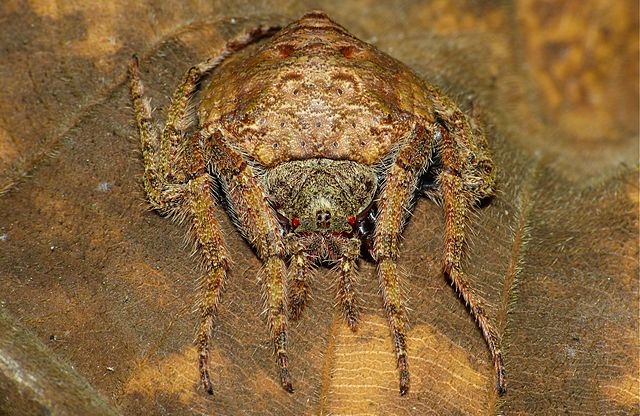If you ever visit the Australian bush, we’re certain you’ll never lean casually or confidently on a tree. The camouflage employed by the wrap around spider is quite effective and not as simple as it looks. This spider not only has small, slit discs on the upper part of its body to help it blend with its surroundings, but also has a neat little addition to help it in hiding effectively… a concavity in its abdomen.
Yes, it really does “wrap around” that tree.
Wrap around spiders only hide during the day, however. At night, they “come alive,” spinning vertical orb webs and eating what they can trap until sunrise, when they once again go into hiding on their favorite tree.
Is the wrap around spider dangerous?
Concerning potential threats, it’s reassuring to learn that, although wrap-around spiders are indeed venomous, their venom lacks the potency to pose significant health risks to humans. Consequently, while a bite might invoke fear and annoyance, it will hardly prove fatal. Despite their formidable appearance in images, these spiders are actually remarkably small in size, dwarfed by the gargantuan Theraphosa blondi, the largest of their kind. Females measure approximately 0.35 inches (9 mm) in length, with males slightly smaller at 0.19 to 0.20 inches (roughly 5 mm).

Native solely to Western Australia, wrap-around spiders typically cling to trees, mirroring the behavior of the deadly assassin caterpillar, though they do occasionally venture down to terra firma. Therefore, on an Australian walkabout, one should be mindful that these creatures might be covertly nestled in trees that appear otherwise innocuous.
You’re welcome.
Discovered by a noble character
The wrap-around spider, scientifically known as Dolophones conifera, owes its identification to Count Eugen Wilhelm Theodor von Keyserling, a name as grand as it is lengthy. The Keyserling lineage (originally Keselingk) ascended to nobility generations ago, sparked by the exploits of Hermann, a mayor’s son, who embarked on crusades and achieved knighthood under the banner of the Brethren of the Sword in 1492. From there, the family’s noble trajectory was ascendant, reaching the esteemed rank of Baron by 1631. Subsequently, in 1742, the inaugural Keyserlingk Count was decreed by Frederick August, King of Poland, who curiously bore the same name as the family’s knighted forefather: Hermann.
Born in 1832 in Pokroy, Lithuania, Count Eugen embarked on a career as an arachnologist. The family’s sentiments towards his profession remain unknown: while they dubbed him “Spiders Keyserling,” it’s uncertain whether the moniker was bestowed with affectionate jest.
Nevertheless, between 1856 and 1864, Count Eugen embarked on numerous research expeditions across the globe before crossing paths with his future spouse, Margarete, in Switzerland.
Margarete’s charm must have been compelling, as Eugen promptly acquired expansive plots of land in Silesia, Poland, opting for a tranquil agricultural life.
Well, for the most part.
The Count later moved to Munich and began classifying spiders that his American friends would send him, eventually writing the much-acclaimed Die Spinnen Amerikas (The Spiders of America)—and probably giving Margarete a fright or two with those first-arriving boxes of spiders. He was even a bit of an artist, providing sharp and detailed illustrations.
In 1886, about three years before his death from cerebral tuberculomas (a serious form of tuberculosis), Count Eugen introduced the world to the wrap-around spider, formally cataloging this diminutive arachnid.
Incidentally, after Eugen died, his son Robert offered his father’s impressive 10,000-spider collection to the Berlin Museum, but they declined. The collection was instead purchased by the Museum of Natural Sciences in London.
Oh, come on now, would you have kept the spiders?


